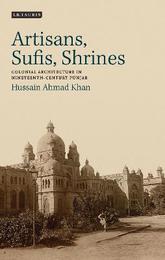
|
Artisans, Sufis, Shrines: Colonial Architecture in Nineteenth-Century Punjab
Hardback
Main Details
| Title |
Artisans, Sufis, Shrines: Colonial Architecture in Nineteenth-Century Punjab
|
| Authors and Contributors |
By (author) Hussain Ahmad Khan
|
| Physical Properties |
| Format:Hardback | | Pages:232 | | Dimensions(mm): Height 216,Width 138 |
|
| Category/Genre | Asian and Middle Eastern history
Colonialism and imperialism |
|---|
| ISBN/Barcode |
9781784530143
|
| Classifications | Dewey:720.954 |
|---|
| Audience | | Tertiary Education (US: College) | |
|---|
| Illustrations |
20 integrated bw
|
|
Publishing Details |
| Publisher |
Bloomsbury Publishing PLC
|
| Imprint |
I.B. Tauris
|
| Publication Date |
19 December 2014 |
| Publication Country |
United Kingdom
|
Description
In nineteenth-century Punjab, a cultural tug-of-war ensued as both Sufi mystics and British officials aimed to engage the local artisans as a means of realizing their ideological ambitions. When it came to influence and impact, the Sufi shrines had a huge advantage over the colonial art institutions, such as the Mayo School of Arts in Lahore. The mystically-inspired shrines, built as a statement of Muslim ruling ambitions, were better suited to the task of appealing to local art traditions. By contrast the colonial institutions, rooted in the Positivist Romanticism of the Victorian West, found assimilation to be more of a challenge. In questioning their relative success and failures at influencing local culture, the book explores the extent to which political control translates into cultural influence. Folktales, Sufi shrines, colonial architecture, institutional education methods and museum exhibitions all provide a wealth of sources for revealing the complex dynamic between the Punjabi artisans, the Sufi community and the colonial British. In this unique look at a little-explored aspect of India's history, Hussain Ahmad Khan explores this evidence in order to illuminate this web of cultural influences. Examining the Sufi-artisan relationship within the various contexts of political revolt, the decline of the Mughals and the struggle of the Sufis to establish an Islamic state, this book argues that Sufi shrines were initially constructed with the aim of affirming a distinct 'Muslim' identity. At the same time, art institutions established by colonial officials attempted to promote eclectic architecture representing the 'British Indian empire', as well as to revive the pre-colonial traditions with which they had previously seemed out of touch. This important book sheds new light on the dynamics of power and culture in the British Empire.
Author Biography
Hussain Ahmad Khan holds a PhD from the National University of Singapore. He is an assistant professor in the Department of Humanities at COMSATS Institute of Information Technology, Lahore.
ReviewsThis book makes a significant contribution to the scholarship on the cultural and social history of the subcontinent's Muslim communities. Dr Maurizio Peleggi, Associate Professor, Dept of History, National University of Singapore and editor of the Journal of Southeast Asian Studies By exploring the intersection of shrine architecture, folklore, festival markets and artisan life, Hussain Ahmad Khan shows the contours of an indigenous "Arts and Crafts Movement" that resisted the Morris-and-Ruskin discourse of colonial art institutions. This is a fascinating addition to the literature on Muslims in colonial Punjab. - Nile Green, UCLA, author of Bombay Islam: The Religious Economy of the West Indian Ocean (Cambridge, 2011) The originality of Khan's study lies in its emphasis that artisanal production is not entirely a secular artefact. In placing craft as a scene of several encounters - of a "positivist" administration with Sufi ideas, of curatorial conceits within an indifferent, confusing profusion of objects and audiences - Khan radically complicates the story so far, combining theological insight with the study of art historical and governmental attitudes. Arindam Dutta, MIT
|